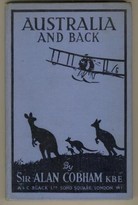First Edition. pp. 124, illusts., endpp. map. Small inscription prelim. Sir Alan John Cobham, KBE, AFC (6 May 1894 – 21 October 1973) was an English aviation pioneer. A member of the Royal Flying Corps in World War I, Alan Cobham became famous as a pioneer of long distance aviation. After the war he became a test pilot for the de Havilland aircraft company, and was the first pilot for the newly formed de Havilland Aeroplane Hire Service. In 1921 he made a 5,000 mile air tour of Europe, visiting 17 cities in 3 weeks. Between 16 November 1925 and 13 March 1926, he made a trip from London to Cape Town and return in his de Havilland DH.50 in which he had replaced the original Siddeley Puma engine with a more powerful, air-cooled Jaguar.[2] On 30 June 1926, he set off on a flight from Britain (from the River Medway) to Australia where 60,000 people swarmed across the grassy fields of Essendon Airport, Melbourne when he landed his de Havilland DH.50 floatplane (it had been converted to a wheeled undercarriage earlier, at Darwin[3]). During the flight to Australia, Sir Alan J. Cobham’s engineer of the D.H.50 aircraft, Mr. Arthur B. Elliot, was shot and killed after they left Bagdad on 5 July 1926. The return flight was undertaken over the same route. He was knighted the same year. #0918
AUSTRALIA AND BACK. (With Foreword by the Rt. Hon. S.M. Bruce Prime Minister of Australia.)
$15.00
Sold Out
Additional Information
| Author | Sir Alan Cobham |
|---|---|
| Publisher | A. & C. Black, London |
| Year Published | 1926 |
| Binding Type | Hardcover original cloth binding. |
|---|
